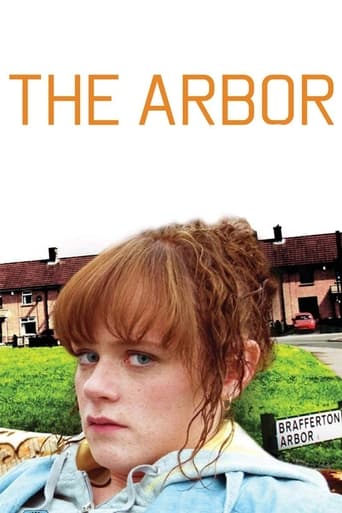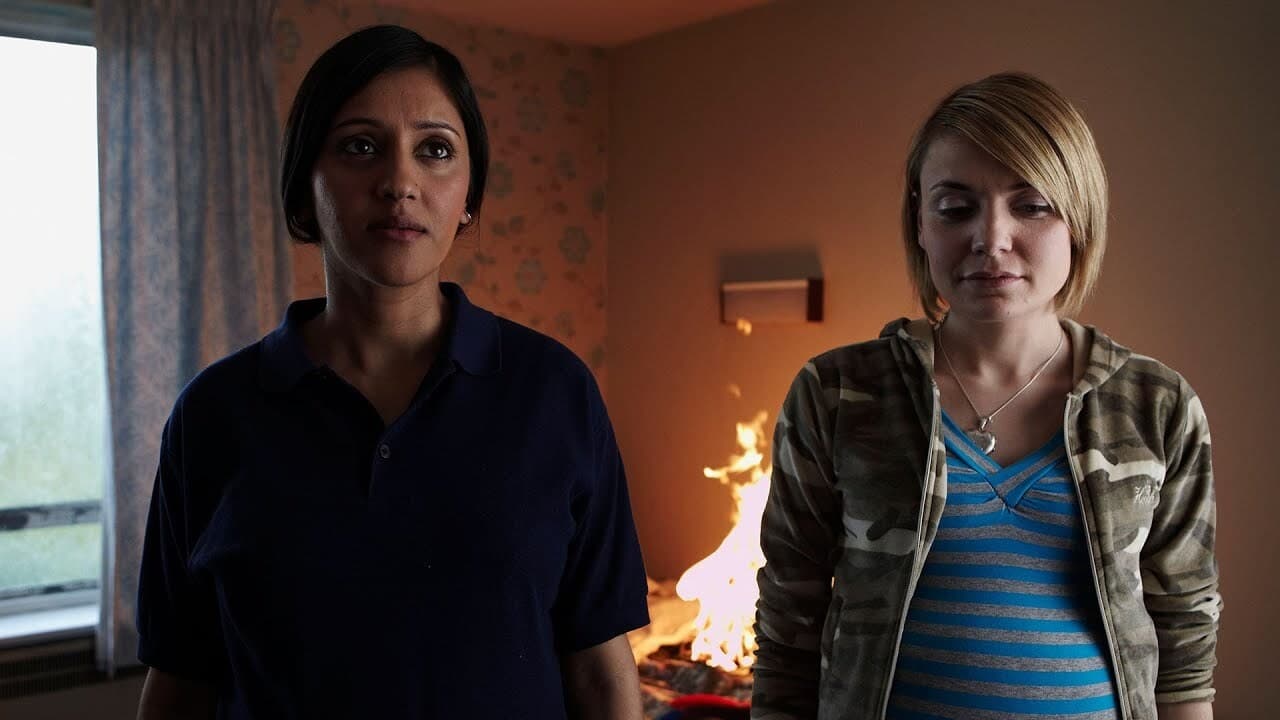greasyfilms
By using actors who are lip-syncing interviews of actual people in Andrea Dunbar's life, this film pushes the documentary genre completely into the dramatic cinema field, with very interesting and moving results. Mix in stagings of her plays in the actual British housing projects where they were set, and vintage TV footage, you get a fascinating very creative mix.It's also a very enlightening portrait of a woman who used art and the written word to pull herself out of the slums, but failed to change as a human being, basically living the life of the housing project trash that she wrote about, abusing her children as a result.A fresh and very cinematic take on the documentary form. Check it out.
didi-5
Andrea Dunbar wrote two plays before she died tragically young at the age of 29 - 'The Arbor', of which we see snatches and scenes here, and 'Rita, Sue and Bob, Too', which was made into a well-regarded film.This drama-documentary is rather different to the usual type because not only does it use real interview and actual footage of Dunbar from her TV appearances, but uses real interviews with her family and friends which are then lip-synched (very well) by professional actors. This sounds like a gimmick, but we very quickly forget we are not watching the real people talking about their lives - when we do get jolted out of this by associations with other work (George Costigan 'plays' Dunbar's partner but also of course was 'Bob' in the aforementioned film), it still somehow works.Dunbar's story was a tragic one, one of wasted talent and a toxic life, to some degree, although her children - mixed-race Lorraine and Lisa - have very different stories about their childhood and the impact their mother had on them. Lorraine's story is just as tragic in its way, and we follow that following the description of Andrea Dunbar's death.A new and dynamic way of presenting real people's issues and problems, 'The Arbor' is very possibly something Dunbar could have created herself had she lived. As it is, it stands as an interesting memorial to her talent.
MrJamesBlack
Andrea Dunbar was something of a child prodigy growing up on the underprivileged Buttershaw Estate in Bradford. Dunbar wrote her first play The Arbor, (named after the street on which she lived Brafferton Arbor,) at the tender age of 15. The play, which debuted at the Royal Court Theatre in 1980, depicts the turbulent life of pregnant teenager with a father who is an abusive alcoholic. In 1982 Dunbar wrote the follow up Rita, Sue and Bob Too! which was later turned into a film by the director Alan Clarke. By 1990, at just 29 years old, Andrea Dunbar was dead, killed by an apparent brain haemorrhage the talented author left behind three young children. Artist and filmmaker Clio Barnard's new biopic, also entitled The Arbor, attempts not only to tell Andrea's story but also that of her eldest daughter Lorraine, who was imprisoned in 2007 for the manslaughter of her son Harris.A drama/documentary in the truest, and perhaps newest, sense of the phrase The Arbor utilizes archive footage culled from television documentaries such as Arena and Look North, an original technique where actors lip-sync to the voices of the real life participants in Dunbar's troubled life and impromptu performances of the author's work taking place on the Buttershaw Estate. Theoretically speaking this multi-layered approach sounds as if it might be somewhat confusing and imprecise in practice however it is a revelation being both innovative and inspiring. With a shifting timeframe and multiple story telling techniques the resulting film not only offers a detailed insight into the lives of Andrea Dunbar and her daughter Lorraine but also into that whole section society recently dubbed 'Broken Britain.' The film begins in the present day with Dunbar's two daughters Lorraine (Manjinder Virk) and Lisa (Christine Bottomley) telling of their childhood and formative years. These scenes, in which the actors address the camera and lip-sync their speech to actual voices of the people they are portraying are carried off with remarkable accuracy and have a haunting quality to them. It is as if the actors are channelling those involved from another time and place with a story yet to be told. The voices of the interviewees are filled with regret rather than anger at wasted opportunities and what might have been, there is also a great deal of understanding at the circumstances and pressures each of them have faced in the past.Life has been particularly difficult for eldest daughter Lorraine growing up as a mixed-race child a predominately white estate she was racially abused on a daily basis for having a Pakistani father. Just 10 years old when her mother passed away Lorraine would later turn to prostitution to feed her drug habit. As her life quickly spiralled out of control she fell pregnant by one of her clients and struggled to bring up her child.The documentary footage of Andrea Dunbar shows the author at home on the Buttershaw Estate where she continued to live until her untimely death. The semi-biographical nature of Dunbar's writing is obvious in the remarkable similarity between her own family and the characters of her creation. Given the present day world of celebrity these scenes, (in which fame appears to have been foisted upon an unassuming talent,) are reminiscent of the countless reality TV stars that are ill-prepared for the spotlight.The scenes in which parts of Dunbar's plays that are acted out on the estate are excellent giving off the urgency and realism of the writing. As the current residents loiter in the background Natalie Gavin who plays the young Andrea enthusiastically explains her work to the camera before launching into another energetic performance.At the conclusion of The Arbor Lorraine, who has now released from prison after serving 3 years for the manslaughter of her son, tells us that her life reflects many inhabitants of the Buttershaw Estate. Where once the social problems were those of unemployment, poverty and alcoholism the estate has deteriorated further becoming a ghetto of drug dealing, crime and disorder. Lorraine tells us that if her mother were to write Rita Sue and Bob Too! in the present day, "Rita and Sue would be smackheads." The lasting influence of Andrea Dunbar's writing can be found in modern British film and television not least in the television drama Shameless which depicts life on the Chatsworth Estate with a similar combination of bawdy humour and satirical knowingness. The Arbor's unusual but innovative approach to drama/documentary uncovers, like Dunbar's plays, the hardship and problems which lie at the heart of working-class Britain, (albeit in a completely different manner.) Exploring the life of a significant contributor to British working-class fiction The Arbor like Andrea Dunbar herself is too authentic and insightful to ignore.
roy-54
If you've seen Alan Clarke's wonderful 'Rita, Sue and Bob Too!' (UK 1986), you'll have some idea of what to expect from 'The Arbor'. "The Arbor" is a small part of the Buttershaw Estate in South Bradford where Clarke's film was set. Clarke's film was adapted from her own play by Andrea Dunbar, a 20 year-old single mother in 1982 when the play first appeared. She had written her first play also called 'The Arbour' when she was still at school and a third, 'Shirley', in 1986 before she died suddenly from a brain haemorrhage aged just 29.Knowledge of 'Rita, Sue and Bob Too!' will only help a little, however. This film, 'The Arbour', is part inspired by but is not an adaptation of Dunbar's play. Instead it is a form of documentary about Dunbar and her personal legacy that turns out to be mainly about the equally difficult life of her first child, Lorraine.The film is written and directed by Clio Barnard who has Bradford connections. She visited the Buttershaw estate in 2009 and interviewed members of the extended Dunbar family and some other residents. She then borrowed the idea of hiring actors to lip-synch the recorded interviews (in A State Affair, a play by Robin Soans about the Buttershaw estate, actors spoke the words of the people Dunbar knew). Scenes with the actors were shot on the estate and in a London studio. They were edited together with two other kinds of material – scenes from 'Rita, Sue . . .' and from arts and news programmes about Andrea Dunbar plus scenes from 'The Arbor' play, acted out on the 'green' on the estate.So, what does it all mean? I'm honestly not sure. Technically it is very well put together. I found myself moved by several scenes. At other times I felt like I didn't want to watch. I think that my personal preference is for a social-realist drama, but I recognise that the approach here is very powerful. My only real problem was in the casting of George Costigan as one of the actors reading the words of one of the fathers of Andrea Dunbar's children. Costigan was 'Bob' in Rita, Sue . . . and I found this an intertextual step too far.Clio Barnard has, I think, previously produced video installations and sometimes I felt that I was viewing an installation. I found the initial stages confusing as they moved backwards and forwards in time, but eventually the film developed a distinctive narrative line focusing on Lorraine and this made it more like a traditional documentary film.The Arbor appears to be attracting audiences to the National Media Museum's cinemas. Bradford audiences will probably have a rather different take on the film than the London critics who celebrated its success in winning two prizes at the London Film Festival this week.


 AD
AD


